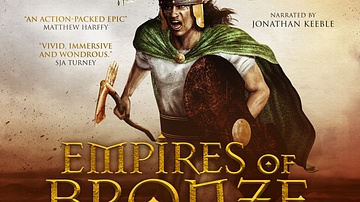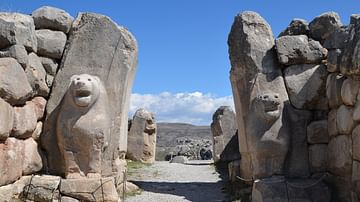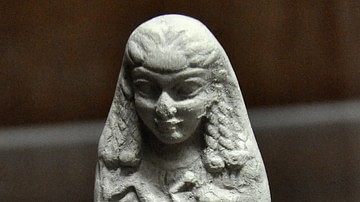Review

| Rating: | |
|---|---|
| Title: | Empires of Bronze I: Son of Ishtar |
| Author: | Gordon Doherty & Simon Walpole |
| Audience: | General Public |
| Difficulty: | Medium |
| Publisher: | www.gordondoherty.co.uk |
| Published: | 2019 |
| Pages: | 425 |
This is a great historical novel chronicling the childhood of Prince Hattusili III and his rise from "cursed one" to successful soldier and "Son of Ishtar". Filled with prophecy, family drama, the beginning of a love story, and an overriding backdrop of war, this book is consistently a good read. I recommend to anyone interested in a good historical novel, with the caveat that there are some graphically detailed violent scenes.
Empires of Bronze: Son of Ishtar is Gordon Doherty's richly detailed fictionalization of events and people who lived during the height of the Hittite Empire. Set in the 1300s BCE, the story follows King Mursili's third son, Hattusili III (Hattu) and his rise from 'cursed son' to respected military leader. Hattu's story begins with a terrible choice: his birth is difficult, and the Goddess Ishtar comes to the King with a bargain no loving husband and father should ever have to make. She will save the son or the queen, but Mursili must choose. The king's heartwrenching decision to save his son and let his beloved wife die sets off a series of events that will change the Hittite Empire and the royal family forever, as Ishtar issues both prophecy and her divine protection to Hattusili.
As a result of his birth, Hattu is simultaneously ignored and despised by his father and considered cursed by the Hittite people. He is given to the royal scribe for training instead of following the usual path of princes to learn military arts, where he is isolated from everyone except his two brothers. When the capital city, Hattusa, is attacked by the terrifying Kaskan tribes and his brother is killed, Hattu's destiny to transform from the 'cursed son' to the Son of Ishtar truly begins. The prophecy involving betrayal, death, and conflict between Hattu and his remaining brother, the crown prince Muwa, is set into motion against the primary tale of Hattu's hero journey from 12-year-old scribe's apprentice to experienced soldier.
His path into military training is fascinating, and Doherty clearly thought through ancient tactics based on the different resources the Hittite military used when writing the campaign scenes. Doherty writes Hattu's time in the Hittite version of boot camp with gritty physical detail and emotional stresses that develop Hattu into a sympathetic character and strong leader.
Doherty is a skilled worldbuilder and storyteller. Using historical and archaeological facts to build on, he creates a robust Ancient Near East, covering nearly every aspect of life in seamless writing that truly brings the Hittite Empire to life. He depicts the Hittites as exactly what they were: a society in Anatolia (modern-day Turkey) surrounded by both allies and enemies, and his inclusion of references to the conflict in Troy and the varying tribes the Hittites faced makes the king's delicate position in global politics feel real. Taking historical details discovered on actual Hittite tablets and integrating them into the novel never feels like a book report: it only adds depth to the overall world he builds.
In addition, all the main male characters have some backstory Doherty's clearly worked out. None have excessive exposition, but all the king's advisors and Hattu's military unit have details worked into the dialog that make them feel real. Perhaps the only character who seems like a cardboard cutout is the priestess Atiya, who becomes a source of tension for the princes. However, this is only the first installment of the series, so it is possible Atiya will become less of a one-dimensional prize to be won, and more of a developed, independent person in the next book.
I enjoyed the story and the Hittite world Doherty created in Empires of Bronze: Son of Ishtar. This book will appeal to anyone interested in detailed descriptions of ancient military structure, training, and tactics as well as anyone who likes a good coming-of-age tale. I will say, I am not generally squeamish about violence, but there are a few seriously violent deaths in graphic torturous detail that make me unwilling to recommend this book for pre-teens or anyone who objects strongly to descriptive war violence. This first book in the series has all the right ingredients to follow a standard hero's journey as well as plot twists that keep it exciting. Overall, an interesting mix of fact and fiction that keep the reader fully engaged.
Cite This Work
APA Style
Settergren, J. (2020, February 20). Empires of Bronze: Son of Ishtar. World History Encyclopedia. Retrieved from https://www.worldhistory.org/review/226/empires-of-bronze-son-of-ishtar/
Chicago Style
Settergren, Jessica. "Empires of Bronze: Son of Ishtar." World History Encyclopedia. Last modified February 20, 2020. https://www.worldhistory.org/review/226/empires-of-bronze-son-of-ishtar/.
MLA Style
Settergren, Jessica. "Empires of Bronze: Son of Ishtar." World History Encyclopedia. World History Encyclopedia, 20 Feb 2020, https://www.worldhistory.org/review/226/empires-of-bronze-son-of-ishtar/. Web. 17 Apr 2025.


